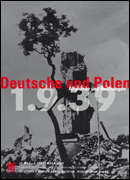


Exhibition | Oppression and Self-assertion | War and Occupation | Conflicts and Rapprochements
The Invasion
| Forced Labor
| Colonization, Deportation, Extermination
Genocide
| Resistance and Self-assertion
The End of the War
| Expulsion of the Germans
| Expulsion of the Poles
Resistance groups with a wide variety of political orientations began to form in occupied Poland. Most of them were loyal to the Polish government-in-exile, which was based first in Paris and then in London. Several of these groups joined forced in 1942 to form the Polish Home Army (Armia Krajowa). During occupation, an underground state was created which even had its own administrative structure.
Polish Jews formed organizations of their own, both civil and military. The highpoint of the Jewish resistance movement was the Warsaw Ghetto Uprising, which lasted from 19 April to 16 May 1943 and served as a symbol of defiance in the face of Nazi rule.
In 1944, the Armia Krajowa launched an offensive in an effort to liberate Polish cities before the arrival of the Red Army and Warsaw revolted on 1 August 1944. By the time the Nazis crushed this revolt in early October, about 180,000 Poles were killed, most of them civilians, as SS and police units perpetrated a massacre of the Polish population.
